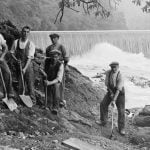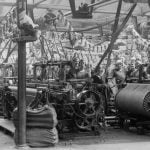As innovation in Jute spinning developed, sackcloth, bagging, and other coarse fabrics which had been made from hemp, flax and coarse tows, began to be made entirely from jute and the linen trade declined except for finer cloths.
At Ashbank Mill, this shift of focus occurred in the late 1870s when new machinery was installed and jute alone was spun.
At this time about 5,000 spindles per week of cops (conical balls of thread) and wefts were produced principally for the Dundee trade. The employees numbered around 100.
The mill was burned down in the 1860s and although re-erected did not recommence working until the early 20th century.
The Lornty Spinning Company under Mr. A. D. Grimond in the first two years of the century carried out modernisation of their mills, and as Ashbank now belonged to them it came into the scheme, and machinery was installed in the new building in 1901. It seems to have been working in September 1903 when a breakdown occurred involving extensive repairs in the main driving arrangements and the opportunity was taken for the alteration of the gearing to let the water wheel run at a more advantageous speed. A reference in the Blairgowrie Advertiser of May 6, 1905 seems to indicate that Ashbank at that time was idle. This must have been only a temporary stoppage following the disbanding of the Lornty Spinning Company, as the mill had been in full operation for a number of years previous to its being destroyed by fire in about 1918.
Ashbank was supplied by water from a weir (or croy) which had, prior to 1903, been shared with Bramblebank Mill across the river. After the fire and destruction of Ashbank this was swept away by floods and its absence, in recent years, necessitated the use of the Westfield weir and buildings for the generation of power for the reconstructed and refitted Bramblebank Works.
In 1843 the number of workers employed there was 72 (32 males, 40 females).
Ashbank Mill was built perpendicular to the river and tenement accommodation was built nearby for the workers.
‘A fine, mansion with garden and some ornamental ground attached was the property of John Baxter Esq who was the proprietor of a large flax mill of the same name situated a little north of the mansion.’
John Baxter’s wife was very well known in the district as a welcoming hostess for many entertainments in the house and garden. She was notable for ‘an irresistible, bright, sunshiny manner, a nimble and perfectly spontaneous wit, and a gift of mimicry that could keep everyone in fits of laughter as long as she chose’. (quoted in Henry Dryerre ‘Blairgowrie and Strathmore Worthies’ p36). Dryerre is fulsome in his praise of her virtues and accomplishments: ‘It was characteristic of the young lady to jump the Keith on the Ericht (Donald Cargill’s Leap) on one occasion – the only instance, it is believed, of A LADY ACCOMPLISHING THE FEAT’.
The mansion was demolished and all that remains of the property is the lodge gatehouse at the main entrance and a few fine specimens of the trees that once graced the fine gardens.
Very little remains of the mill and tenements with just a few stones and foundations scattered among the undergrowth.
As many of the mills along the Ericht were built into the river bank they were named after local features and incorporated ‘bank’ into their names (Oakbank, Ashbank, Bramblebank, Keathbank).


